The "hazards" of driving in Chile
Every country has its driving norms and after driving 2,500 kilometres in Chile, I think I've figured out at least one that you might want to have in the back of your mind before visiting!
This piece is also part of Episode 4 of the Tales under the cat tree podcast
A man is standing at a crosswalk just before two lanes filled with traffic spill out into a roundabout. My foot slides gently onto the brake; I wasn’t going that fast. I glance reflexively at the rearview mirror. For a second, I do a double take, and almost slam my foot down at the sight. A car has managed to pull up behind me speedily from the other lane. The driver is now gesticulating madly. Had he a passenger, I’m certain they would have plugged their ears. As it was, we were both in the world of the driven mime artist. His hands—yes both—are out making the universal sign for “turn on your hazard lights” followed by both hands doing the upturned back palm miming “what the heck is wrong with you?!”—I’m trying to be polite—my mum might be reading this. Ah, yes. I turn on the hazard lights; I’m driving in Chile.
In case you get the wrong message, for the most part, Chile is a wonderful country in which to drive. Over a two-month period, I rented two cars. The first took us around the Atacama, from Antofagasta through San Pedro de Atacama to Arica, the northernmost city in Chile, and back. The second time we experienced the south from Concepción to the volcanic region close to the border with Argentina. A car is essential to leisurely exploring a country that spans from near the equator to the very tip of South America. Despite our gesticulating friend, Chile is also a courteous country when it comes to other drivers—for the most part.
It turns out, despite any official material or training, in Chile, your default mechanism for signaling anything happening on the road to others is to turn on your emergency blinkers. This can truly be for any sort of hazard. A cow on the road? Hazard lights. A person waving you down? Hazard lights. Are you approaching a set of lights that you already saw but now they are red and you don’t know if anyone else is paying attention? Hazard lights. Turning and you don’t want the person behind you to rear-end you even if you are using your turn lights? You get the picture.
An Argentinian hitchhiker, whom we delivered to his house, said: “This country is weird with the blinking lights! In all my 15 years here, you can do no wrong on the road as long as you put on the emergency blinkers!” He had been a bit reticent as a hitchhiker until I asked if this was the same in other South American countries. At this point his eyes lit up and we explored the topic in an animated fashion.
In Canada, or Finland, and seemingly in the official documentation for Chile, your hazard lights are there to signal an emergency or unusual circumstances. I can think of only a handful of times that I’ve used them; my hand just doesn’t move reflexively to that button. I believe the design, having the button in the center console of most cars is meant to prevent you from immediately punching it. In Chile though, I guess the normal way of driving means increasing the level of “unusual circumstances” to include pedestrian crossings. On the other hand, as a pedestrian, I did appreciate the visible notice that the car has seen me and wouldn’t be running me over. In all, not a bad thing, just a cultural difference I had never considered.
We concluded almost 2,500 kilometres of driving during our time in Chile. If I include the numerous Ubers, buses, and other vehicles, then that count increases by an even larger margin. On occasion I would see news of some grisly accident on Ruta 5, the main highway running the length of Chile. This is understandable to some extent. The road covers immense distances with a large volume of diverse vehicles; from giant mining trucks in the Atacama to overloaded little cars.
In the north, the high Altiplano allows for a two-lane black strip carved into the vast, arid salt flats. The road stretches straight and as far as the eye can see. Every so often we would come across memorial crosses by the side of the road. The crosses seemed to indicate many different possible accidents: vehicles may have turned a tight corner too fast and fallen into 1,000 m deep canyons, or driven off the road in bad weather, or the driver had simply fallen asleep at the wheel while passing through the unchanging landscapes of the north.
At first we counted the crosses, but after some dozens of kilometres, we lost count. Some memorials to the fallen were elaborate with pictures, lights, and shelters; all continued to be lovingly maintained by the families of the lost. Some had even been carefully moved by road builders as the roads were being renewed. I suspect it is a measure of respect from one citizen to another on these roads.
It’s not like we didn’t also come close to being a marker on a road. On the very last day, I, the poorly observant driver, turned the car onto a poorly signed construction road. We were narrowly missed by a construction vehicle which sped and swerved in a panic through my blind spot.
Neither vehicle had our emergency blinkers on.


